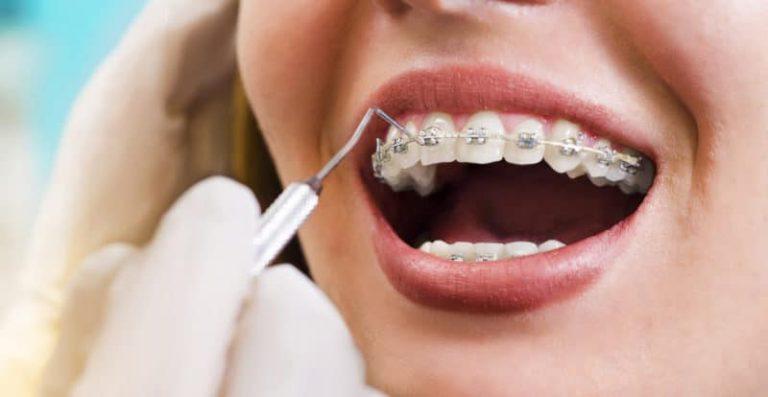There are several different types of braces or correction appliances available. The most common type of braces are stainless steel or ceramic/porcelain attachments that are placed on either the front or the back side of the teeth and used as anchors to straighten and align the teeth. Self-ligating braces have replaced the need for rubber ties to hold the wire in places, instead having a latch or door on the bracket to open and close to fix the wire in place. The use of clear aligners is used when aesthetics are a concern.
For most people, a beautiful smile is the most obvious benefit of orthodontics. After your braces come off, you’ll feel more self-confident. During your treatment, we want you to feel as comfortable as possible.
Orthodontic appliances can be made of metal, ceramic, or plastic. They may be removable or they may be brackets bonded to the inside or the outside of the teeth. By placing a constant, gentle force in a carefully controlled direction, braces slowly move teeth to a corrected position. This is a great time to wear braces! Gone are the days when a metal band with a bracket was placed around each tooth. Wires are also less noticeable than they used to be and the latest materials move teeth faster with less discomfort to patients.
Treatment time typically ranges from one to three years, depending on the growth of the patient’s mouth and face and the severity of the problem. Patients grow at different rates and will respond variously to orthodontic treatment, so the time to case completion may differ from the original estimate. The patient’s diligent use of any prescribed rubber bands or headgear is an important factor in achieving the most efficient treatment. Interceptive, or early treatment procedures, may take as few as six months.
What can you eat? Let’s talk about what you shouldn’t eat! If you’ve been wanting to drop a few pounds, the first week wearing braces is just your chance! For the first day or so, stick to soft foods. Avoid tough meats, hard breads, and raw vegetables. Before long, you’ll be able to bite a cucumber again. But you’ll need to protect your orthodontic appliances when you eat for as long as you’re wearing braces.
When you get your braces on, you may feel general soreness in your mouth and teeth may be tender to biting pressures for three to five days. This can be relieved by rinsing your mouth with a warm saltwater mouthwash. Dissolve one teaspoonful of salt in 8 ounces of warm water, and rinse your mouth vigorously. If the tenderness is severe, take aspirin or whatever you normally take for headache or similar pain. The lips, cheeks and tongue may also become irritated for one to two weeks as they toughen and become accustomed to the surface of the braces. You can put wax on the braces to lessen this. We’ll show you how!
This is to be expected throughout treatment. Don’t worry! It’s normal. Teeth must loosen first so they can be moved. The teeth will again become rigidly fixed in their new – corrected – positions.
To successfully complete your orthodontic treatment plan, patients must work together with the orthodontist. The teeth and jaws can only move toward their corrected positions if the patient consistently wears the elastics (rubber bands), headgear or other appliances as prescribed. The following paragraphs describe the types of appliances that may be used during your treatment.
Wearing elastics (rubber bands) improves the fit of your upper and lower teeth. Wear rubber bands as instructed because the rubber bands work far more efficiently if they are worn as prescribed.
Headgear is used to treat patients whose teeth are in an “overbite,” (with the uppers forward of the lowers) or an “underbite” (with the lowers forward of the uppers). Headgear gently “pulls” on your teeth to restrict further forward growth of your upper teeth and jaw.
The Quad Helix appliance “expands” (widens) the upper jaw in growing children by placing gentle pressure on the inside of the upper teeth. Your orthodontist will check and make adjustments to the appliance periodically. Once the desired expansion is achieved the appliance is removed and a removable retainer is worn to stabilize the expansion.
The twin block appliance is a removable appliance, it is designed to position the lower jaw forward and encourage lower jaw growth. This appliance is used mostly in growing individuals. Typically the twin block is worn for approximately 10-12 months, then followed with full upper and lower braces to correct the bite.
Traditional metal braces are the most common type of braces and are more comfortable today than ever before. Made of high-grade stainless steel, metal braces straighten your teeth using metal brackets and archwires. With metal braces, you have the option of adding colored elastics (rubber bands) for a more unique and colorful smile.
Ceramic braces are made of clear materials and are therefore less visible on your teeth than metal braces. For this reason, ceramic braces are used mainly on older teenagers and adult patients who have cosmetic concerns. While they are visually less prominent, they do require more attention to oral hygiene as ceramic braces are larger and are more brittle than their metal counterparts. For these reasons, ceramic braces tend to be used more on upper front teeth than on lower teeth.
Small rubber band that is hooked between different points on the appliance to provide pressure to move the teeth.
Welded or removable arm which elastics (rubber bands) are attached.
A thin ring of metal fitted around a tooth and cemented in place. The band provides a way to attach the brackets to the tooth.
Fine wire that is twisted around the bracket to hold the archwire in place.
